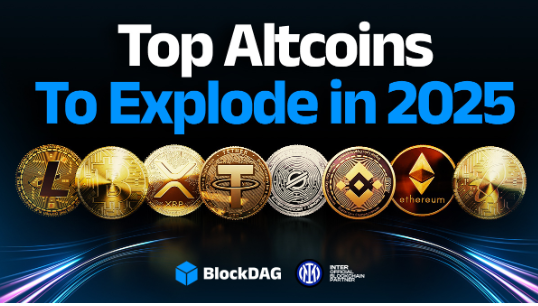Top Altcoin to Buy Now: BlockDAG, Atom, GRB & Arbitrum Are Leading in 2025—Explore Why!

The crypto world often feels like nonstop noise, with coins rising and falling fast. But beyond the hype, a few standouts like BlockDAG, Atom, GRB, and Arbitrum are building strong foundations for the future. These names are not chasing quick gains—they are quietly building solid networks and real utility.
This article breaks down why these four are the top altcoins to buy now. Each is gaining real momentum and could offer strong long-term potential.
1. BlockDAG: Strong Growth and Clear Plans
BlockDAG (BDAG) is showing clear progress. After Keynote 3, its roadmap looks sharp: the mainnet is coming soon, the dev tools are growing, and its mobile mining system is gaining speed.
The presale has hit 27 batches and raised $215 million, selling 19.2 billion BDAG. From $0.001 to $0.0248, that’s a 2,380% increase. Looking ahead, BDAG could reach $1 after mainnet launch—about 3,932% growth. By 2027, it could rise to $20, and by 2030, $30.
Driving this is the X1 Miner App with over 1 million users. No hardware is needed—just a phone, with up to 20 BDAG mined per session. For a project nearing exchange listings, that’s a solid way to build early gains.
Others are still working on utility. BlockDAG is already showing results. From early support to working systems, it stands out as a top altcoin to buy now.
2. Cosmos (ATOM): Technical Strength Meets Adoption Challenges
With a current price of $4.28, Cosmos (ATOM) positions itself as a top altcoin to buy now due to its Inter-Blockchain Communication (IBC) protocol, which facilitates cross-chain interoperability. Despite this innovation, mainstream adoption remains limited.
The network holds $1.9 billion in staked value, reflecting a robust user base. Yet, market sentiment is subdued, evidenced by a Fear & Greed Index of 26. Analysts forecast ATOM may reach $6.65 by mid-2024, signaling slow but steady progress. For broader relevance, Cosmos must translate its tech framework into more widespread ecosystem participation.
3. The Graph (GRT): Infrastructure Backbone for Web3 Integration
Designed to streamline data access for decentralized applications, The Graph supports developers by indexing blockchain data, functioning similarly to how Google organizes web content. As Web3 adoption grows, the utility of such infrastructure becomes increasingly critical—making GRT a top altcoin to buy now.
GRT is priced at $0.079. Projections estimate a rise to $0.09 within the month. Longer-term outlooks suggest potential highs between $1.00 and $1.78 by 2026, contingent on increased developer adoption and consistent network activity.
4. Arbitrum (ARB): Ethereum Scaling with Governance Utility
Arbitrum addresses Ethereum’s scaling limitations by using rollup technology to enhance speed and reduce fees. Its governance-centric approach allows holders to vote on network proposals, giving ARB functional significance within its ecosystem. The current trading price is around $0.295.
Forecasts suggest a value range between $1.22 and $4.01 by 2025. By 2030, the outlook becomes more bullish, projecting prices between $9.15 and $11.59. With Ethereum’s scalability being a persistent issue, Arbitrum maintains its place among the top altcoins to buy now..
Strategic Takeaways
Identifying the top altcoins to buy now involves evaluating their unique utilities and developmental trajectories. Cosmos, The Graph, and Arbitrum each address different facets of the blockchain landscape—interoperability, data infrastructure, and scalability.
Cosmos emphasizes seamless blockchain connectivity, while The Graph strengthens the Web3 data layer. Arbitrum focuses on Ethereum’s performance and governance model.
BlockDAG, meanwhile, has been marking significant milestones. With the release of Keynote 3 detailing technical advancements, over $215 million raised in its presale, and more than 1 million users on its X1 Miner App, its ecosystem is showing substantial growth. With its upcoming mainnet and mobile-centric mining model, BlockDAG aligns with forward-looking infrastructure needs in 2025 and beyond.




